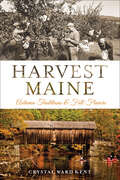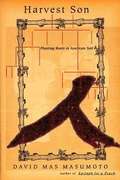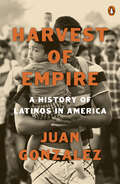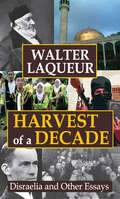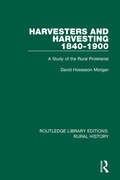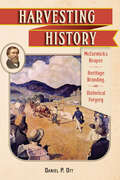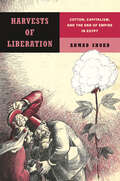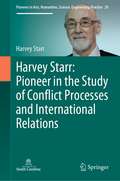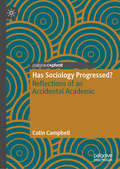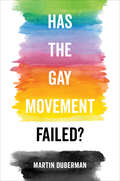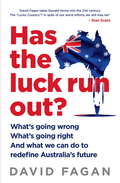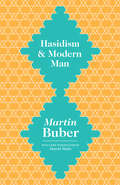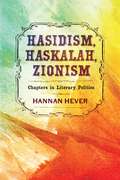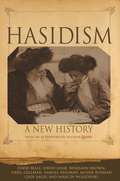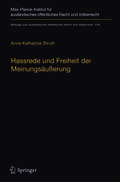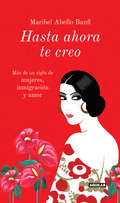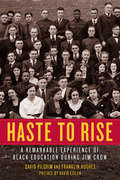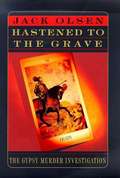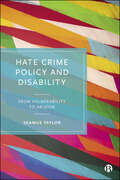- Table View
- List View
Harvest Maine: Autumn Traditions & Fall Flavors
by Crystal Ward KentExperience the fairs, feasts and foliage that herald harvest time in the Pine Tree State. Autumn traditions and flavors come alive in this nostalgic journey through New England's favorite season. Nature lore follows the ways of moose and bear and the great fall migrations of hawks and Monarch butterflies. Old-time fairs still feature horse-pulling, handcrafts and pie-baking contests. Apples, pumpkins and potatoes offer a delectable bounty for the table. Classic recipes for Indian pudding, apple pie, baked beans and brown bread round out this harvest-time sampler. Author Crystal Ward Kent serves up a slice of Maine at its finest.
Harvest Son: Planting Roots in American Soil
by David Mas MasumotoA Japanese-American farmer offers a tribute to family, farm and community. In prose of zen-like calm and clarity, Masumoto relates how he learned how to prune vines and survive a storm; to value the knowledge of old farmers and rusty tools; and to take on a leadership role in his Buddhist community.
Harvest of Empire
by Juan GonzalezA sweeping history of the Latino experience in the United States- thoroughly revised and updated. The first new edition in ten years of this important study of Latinos in U.S. history, Harvest of Empire spans five centuries-from the first New World colonies to the first decade of the new millennium. Latinos are now the largest minority group in the United States, and their impact on American popular culture-from food to entertainment to literature-is greater than ever. Featuring family portraits of real- life immigrant Latino pioneers, as well as accounts of the events and conditions that compelled them to leave their homelands, Harvest of Empire is required reading for anyone wishing to understand the history and legacy of this increasingly influential group.
Harvest of Empire: A History of Latinos in America (Revised Edition)
by Juan GonzálezA sweeping history of the Latino experience in the United States- thoroughly revised and updated. The first new edition in ten years of this important study of Latinos in U. S. history, Harvest of Empire spans five centuries-from the first New World colonies to the first decade of the new millennium. Latinos are now the largest minority group in the United States, and their impact on American popular culture-from food to entertainment to literature-is greater than ever. Featuring family portraits of real- life immigrant Latino pioneers, as well as accounts of the events and conditions that compelled them to leave their homelands, Harvest of Empire is required reading for anyone wishing to understand the history and legacy of this increasingly influential group.
Harvest of Empire: A History of Latinos in America: Second Revised and Updated Edition
by Juan GonzalezA sweeping history of the Latino experience in the United States- thoroughly revised and updated. The first new edition in ten years of this important study of Latinos in U.S. history, Harvest of Empire spans five centuries-from the first New World colonies to the first decade of the new millennium. Latinos are now the largest minority group in the United States, and their impact on American popular culture-from food to entertainment to literature-is greater than ever. Featuring family portraits of real- life immigrant Latino pioneers, as well as accounts of the events and conditions that compelled them to leave their homelands, Harvest of Empire is required reading for anyone wishing to understand the history and legacy of this increasingly influential group.
Harvest of a Decade: Disraelia and Other Essays
by Walter LaqueurThis is a selection of essays written during the first decade of the twenty-first century, by a figure widely acknowledged as the conscience of European liberalism. In Walter Laqueur's lifetime, there have been more acutely dangerous situations, such as the coming of a world war or the seemingly unstoppable march to victory of totalitarian regimes, than in any other previous epoch. Such immediate dangers may not exist at the present time. But long-term trends are equally or even more threatening, as we now see in the ability of small groups of people, unprecedented in history, to inflict enormous damage. This is the underlying essence of Laqueur's thinking, as expressed in this new volume. As Laqueur observes, one learns from long experience that the worst does not always happen, and if it does, probably not in one's lifetime. Ideas and intellectual fashions emerging from the groves of academe, particularly in America can seem wrongheaded and often out of touch with the real world. This growing isolation causes growing bitterness, alienation, and a feeling of impotence on the part of intellectuals, which turns into greater radicalization and farfetched thinking. Laqueur fortunately does not fall into this trap. The articles and essays selected for this volume deal with a variety of topics. They do not entirely reflect Laqueur's interests, which during this period were more in the cultural field than in politics. However, politics intrude irrespective of the author's predilections. Laqueur deals with unpleasant truths in concrete geopolitical settings, but poignantly takes his stand with the men and women who strive to overcome self-censorship in the search for accurate judgment.
Harvest the Wind: America's Journey to Jobs, Energy Independence, and Climate Stability
by Philip WarburgWinds sweeping across the Great Plains once robbed the Farm Belt of its future, stripping away overworked topsoil and creating the dreaded Dust Bowl of the 1930s. Today, those winds are bringing new hope to the declining rural communities of the central United States. Nowhere is wind's promise more palpable than in Cloud County, Kansas, home to the Meridian Way Wind Farm, whose turbines are boosting farm incomes and bringing green jobs to a community that has watched its children flock elsewhere. Modern wind power is the best thing to hit this stretch of midwestern prairie since the Union Pacific railroad.In Harvest the Wind, Warburg brings us the people behind the green economy-powered resurgence in Cloud County and communities like it across the United States. This corner of Kansas is the first stop on an odyssey that introduces readers to farmers, factory workers, biologists, and high-tech entrepreneurs--all players in a transformative industry that is taking hold across America and around the globe.Harvest the Wind serves as an earthly antidote to the more abstract treatises on global warming and green energy. By showing us how practical solutions are being implemented at the local level, Warburg offers an inspirational look at how we can all pursue a saner and more sustainable energy future.
Harvesters and Harvesting 1840-1900: A Study of the Rural Proletariat (Routledge Library Editions: Rural History #12)
by David Hoseason MorganDuring the second half of the nineteenth century the enormous increase in agricultural production, unmatched by technical advance in harvesting, drew vast numbers of rural and migrant workers into the harvest that lasted from June to October. This book, first published in 1982, examines the technology, conditions and customs of the harvest and, through that, the life of the rural population of central England from the 1840s until the end of the century when hand tools finally gave way to mechanisation. The economic framework of the period in agriculture is set out and there flows a detailed analysis of hand tools and work methods in the harvest. The population of harvesters, agricultural labourers and their entire families, townspeople and the gangs of migrant workers are studied, as are the crops they harvested.
Harvesting History: McCormick's Reaper, Heritage Branding, and Historical Forgery
by Daniel P. OttHarvesting History explores how the highly contentious claim of Cyrus McCormick&’s 1831 invention of the reaper came to be incorporated into the American historical canon as a fact. Spanning the late 1870s to the 1930s, Daniel P. Ott reveals how the McCormick family and various affiliated businesses created a usable past about their departed patriarch, Cyrus McCormick, and his role in creating modern civilization through advertising and the emerging historical profession. The mythical invention narrative was widely peddled for decades by salesmen and in catalogs, as well as in corporate public education campaigns and eventually in history books, to justify the family&’s elite position in American society and its monopolistic control of the harvester industry in the face of political and popular antagonism. As a parallel story to the McCormicks&’ manipulation of the past, Harvesting History also provides a glimpse of the nascent discipline of history during the Progressive Era. Early historians were anxious to demonstrate their value in the new corporate economy as modern professionals and &“objective&” guardians of the past. While ethics might have prevented them from being historians for hire, their own desire for inclusion in the emerging middle class predisposed them to be receptive to the McCormicks&’ financial influence as well as their historical messages.
Harvests of Liberation: Cotton, Capitalism, and the End of Empire in Egypt
by Ahmad ShokrIn the first half of the twentieth century, a major change occurred in Egyptian nationalist understandings of imperialism and economic sovereignty. Where once the volatilities of foreign markets and capital were seen as the main threat, over time large landowners and their imperial allies were targeted as the principal obstacles to the country's industrial progress. The perceived locus of imperial domination shifted from the realm of circulation to the realm of production. Harvests of Liberation situates this transformation in the midcentury dynamics of agrarian capitalism in Egypt. Ahmad Shokr tells a story of decolonization through the lens of cotton, Egypt's prized export. He follows a range of actors—colonial advisors, nationalist leaders, agrarian reformers, merchant-financiers, landowners, and rural workers—whose interactions moved the levers of the cotton trade from institutions that facilitated accumulation on an imperial scale to new sites of control within the nation-state. Amidst depression and war, the transformation of Egypt's cotton economy prompted nationalists to embrace policies of land reform and industrialization and adopt a new conception of history. Ultimately, Shokr argues, these efforts set the stage for the construction of a postcolonial republic under Gamal Abdel Nasser, where national liberation became equated with national development.
Harvey Starr: Pioneer in the Study of Conflict Processes and International Relations (Pioneers in Arts, Humanities, Science, Engineering, Practice #29)
by Harvey StarrThis book sets out, through Starr’s personal story, his interest in how the ideas of “intellectual trajectories” and “political memories” could be incorporated into intellectual autobiography, thus exploring how the personal lives of individual academics intersected with their professional interests. By following the development of his approach to research, interdisciplinarity, the logic of inquiry, and the opportunity and willingness framework scholars and researchers will see how his groundbreaking research in Conflict Processes and International Relations Theory developed and were interlinked (especially diffusion, geography and spatiality; the democratic peace and integration; decision making). In addition, graduate students and junior faculty should find useful hints about how to navigate their way through the complexities of becoming both a professional and successful academic and scholar.• This book provides the most complete treatment of the work and contributions of Harvey Starr, a former President of the International Studies Association. • Important for contemporary students of international relations, and their understanding of IR theory and methods.• Demonstrates an eclectic linking of theoretical, logical, and empirical approaches to the study of IR—providing a critical logic of inquiry to do research.• Provides insights and blueprints for how to develop interdisciplinary and multidisciplinary scholarship, highlighting geography and social-psychology.• Affords graduate students and recent Ph.D.s guidance in the development of research, becoming a professional, and the choices to be made in one’s academic career.
Has Feminism Changed Science?
by Londa SchiebingerDo women do science differently? And how about feminists--male or female? The answer to this fraught question, carefully set out in this provocative book, will startle and enlighten every faction in the "science wars." Has Feminism Changed Science? is at once a history of women in science and a frank assessment of the role of gender in shaping scientific knowledge. Science is both a profession and a body of knowledge, and Londa Schiebinger looks at how women have fared and performed in both instances. She first considers the lives of women scientists, past and present: How many are there? What sciences do they choose--or have chosen for them? Is the professional culture of science gendered? And is there something uniquely feminine about the science women do? Schiebinger debunks the myth that women scientists--because they are women--are somehow more holistic and integrative and create more cooperative scientific communities. At the same time, she details the considerable practical difficulties that beset women in science, where domestic partnerships, children, and other demanding concerns can put women's (and increasingly men's) careers at risk. But what about the content of science, the heart of Schiebinger's subject? Have feminist perspectives brought any positive changes to scientific knowledge? Schiebinger provides a subtle and nuanced gender analysis of the physical sciences, medicine, archaeology, evolutionary biology, primatology, and developmental biology. She also shows that feminist scientists have developed new theories, asked new questions, and opened new fields in many of these areas.
Has Sociology Progressed?: Reflections of an Accidental Academic
by Colin CampbellLooking back over the last 60 years of sociology in the UK, this book addresses the question of progress in the discipline. Campbell's critical and autobiographical reflections offer fresh insights into the history of sociology, and engages with the notion of academic reputation, how it is measured, and what it can tell us about scholarly progress. Has Sociology Progressed? will be of special interest to all sociologists and would-be sociologists interested in the past, present and future of their discipline, as well as scholars contemplating academic progress and motivation in general.
Has Wal-Mart Found Its Soul?
by Charles FishmanThe behind-the-scenes report on how Wal-Mart has become arguably the most powerful force for environmental change anywhere. In his national bestseller The Wal-Mart Effect, award-winning journalist Charles Fishman penetrated the store's once impenetrable wall of secrecy to chart Wal-Mart's impact on workers, suppliers, communities, and even the way we see the world and delivered to readers a high-resolution portrait of a business that has evolved into a vast economic ecosystem. Since The The Wal-Mart Effect was published in 2006, the store has gone from being one of the most reviled--and scrutinized--corporations in America to being an outspoken proponent of sustainable practices. How did Wal-Mart pull off such a reputation overhaul? In his new introduction to The Wal-Mart Effect, Fishman chronicles the work of Wal-Mart CEO Lee Scott whose mission became to reconcile how Wal-Mart shoppers feel about the store with how Wal-Mart is viewed by critics. By providing a forum for Wal-Mart watchdogs to sound off, and through a reexamination of business procedures and motivations, Scott shifted the company's focus to sustainability and the environmental impact of capitalism. Wal-Mart has emerged from this revolution as a powerful and conscientious player in this ever-evolving economy.
Has the Gay Movement Failed?
by Martin DubermanThe past fifty years have seen significant shifts in attitudes toward LGBTQ people and wider acceptance of them in the United States and the West. Yet the extent of this progress, argues Martin Duberman, has been more broad and conservative than deep and transformative. One of the most renowned historians of the American left and the LGBTQ movement, as well as a pioneering social-justice activist, Duberman reviews the half century since Stonewall with an immediacy and rigor that informs and energizes. He revisits the early gay movement and its progressive vision for society and puts the left on notice as failing time and again to embrace the queer potential for social transformation. Acknowledging the elimination of some of the most discriminatory policies that plagued earlier generations, he takes note of the cost—the sidelining of radical goals on the way to achieving more normative inclusion. Illuminating the fault lines both within and beyond the movements of the past and today, this critical book is also hopeful: Duberman urges us to learn from this history to fight for a truly inclusive and expansive society.
Has the Luck Run Out?: What we can do to redefine Australia's future
by David FaganWhy are Australians anxious and pessimistic?Who or what has caused our loss of trust in Australia?Why has a feeling of powerlessness crept in for so many? Has the luck really run out for the lucky country?And what can we do to get it back? Every generation believes its forebears have messed up the planet. That's how we evolve.But the mood in Australia at the moment, for all ages, seems one of gloom. People are angry. Distrustful. And not just because we are losing Prime Ministers faster than we are losing wickets!Sport, business, education, banking, farming, religion, trade unions, charities and hospitals have all lost their way through a series of scandals that we must learn from. And disillusion with our leaders is at its peak. Policy has been replaced by politicking.Commentator, author and former newspaper editor David Fagan asks the questions we all want answered as he traces the not-so-gentle decline of important Australian institutions. Through analysis and interviews with experts he explores what has defined Australia in the past and how we want to be defined in the future. Peeling back the rot that has contaminated almost everything Australians believe in, he asks: are we still the economically, socially and culturally strong country that most aspire to? Should we be alarmed? Or has the laconic Australian drifted from believing 'she'll be right' to being a 'bloody knocker'?Has the Luck Run Out? shines a spotlight on the mistakes we have made, our national disillusion and looks to what can be done to re-set the mood of the times. And, more importantly, what we have to do to set things right.
Hasidism and Modern Man
by Martin Buber David Biale Maurice FriedmanHasidism, a controversial, mystical-religious movement of Eastern European origin, has posed a serious challenge to mainstream Judaism from its earliest beginnings in the middle of the eighteenth century. Decimated by the Holocaust, it has risen like a phoenix from the ashes and has reconstituted itself as a major force in the world of ultra-Orthodox Judaism. Philosopher Martin Buber found inspiration in its original tenets and devoted much of his career to making its insights known to a wide readership. First published in 1958, Hasidism and Modern Man examines the life and religious experiences of Hasidic Jews, as well as Buber's personal response to them. From the autobiographical "My Way to Hasidism," to "Hasidism and Modern Man," and "Love of God and Love of Neighbor," the essays span nearly half a century and reflect the evolution of Buber's religious philosophy in relation to the Hasidic movement. Hasidism and Modern Man remains prescient in its portrayal of a spiritual movement that brings God down to earth and makes possible a modern philosophy in which the human being becomes sacred.
Hasidism, Haskalah, Zionism: Chapters in Literary Politics (Jewish Culture and Contexts)
by Hannan HeverHasidism, Haskalah, Zionism reveals how political and literary dialogues and conflicts between the Hebrew literature of the Hasidism, the Jewish Enlightenment, and Zionism interacted with each other in the nineteenth century. Hannan Hever uses postcolonial theories and theories of nationality to analyze how Jews used literature to make sense of hostility directed toward Jews from their European “host” countries and to set forth their own ideas and preferences regarding their status, control, and treatment. In doing so, Hever theorizes the Enlightenment’s intellectual aims and cultural influences, tracking how the models of integration crucial to Haskalah gave way to Jewish nationalism in the twentieth century.The readings in this book are theoretically informed, setting forward novel claims based on detailed textual analyses of hasidic tales, Haskalah satires, and Zionist narratives. Thus, this book tackles a major interpretative problem visible at the core of modern Hebrew literature—its radical difficulty in distinguishing between the theological components of modern Jewish discourse and its national identity.
Hasidism: A New History
by David Biale Arthur Green Moshe Rosman David Assaf Samuel Heilman Benjamin Brown Uriel Gellman Gadi Sagiv Marcin WodzińskiThe first comprehensive history of the pietistic movement that shaped modern JudaismThis is the first comprehensive history of the pietistic movement that shaped modern Judaism. The book’s unique blend of intellectual, religious, and social history offers perspectives on the movement’s leaders as well as its followers, and demonstrates that, far from being a throwback to the Middle Ages, Hasidism is a product of modernity that forged its identity as a radical alternative to the secular world.Hasidism originated in southeastern Poland, in mystical circles centered on the figure of Israel Ba'al Shem Tov, but it was only after his death in 1760 that a movement began to spread. Challenging the notion that Hasidism ceased to be a creative movement after the eighteenth century, this book argues that its first golden age was in the nineteenth century, when it conquered new territory, won a mass following, and became a mainstay of Jewish Orthodoxy. World War I, the Russian Revolution, and the Holocaust decimated eastern European Hasidism. But following World War II, the movement enjoyed a second golden age, growing exponentially. Today, it is witnessing a remarkable renaissance in Israel, the United States, and other countries around the world.Written by an international team of scholars, Hasidism is a must-read for anyone seeking to understand this vibrant and influential modern Jewish movement.
Hassrede und Freiheit der Meinungsäußerung: Der Schutzbereich der Meinungsäußerungsfreiheit in Fällen demokratiefeindlicher Äußerungen nach der Europäischen Menschenrechtskonvention, dem Grundgesetz und der Charta der Grundrechte der Europäischen Union (Beiträge zum ausländischen öffentlichen Recht und Völkerrecht #278)
by Anna Katharina StruthDieses Buch analysiert den grundrechtlichen Schutzbereich der Garantien der Meinungsäußerungsfreiheit in den Grundrechtskatalogen der EMRK, des Grundgesetzes und der Grundrechtecharta der EU. Das Werk untersucht, inwieweit Hassreden und vergleichbare demokratiefeindliche Äußerungen vom Schutzbereich der Meinungsäußerungsfreiheit umfasst sind. Die Autorin setzt sich mit der zu diesen Äußerungen ergangenen Rechtsprechung der zuständigen Gerichte auseinander. Sie kommt über ausführliche Auslegungserwägungen zu den relevanten Bestimmungen zum Ergebnis, dass die Äußerungen, auch wenn sie einen Grundrechtsmissbrauch darstellen, im Schutzbereich der Meinungsäußerungsfreiheit liegen und ihr Verbot einen rechtfertigungsbedürftigen Eingriff in das Grundrecht darstellt. Diese Schlussfolgerung wird mit der Feststellung verbunden, dass die Anforderungen an die Rechtfertigung eines solchen Eingriffs wegen der in diesen Fällen typischerweise vorliegenden Interessenlage regelmäßig erfüllt werden können.
Hasta ahora te creo
by Maribel Abello BanfiUno de los relatos literarios y periodísticos más bellos y mejor logrados sobre algunas de las mujeres colombianas más representativas del caribe colombiano. Durante veinte años, la reconocida periodista y actriz Maribel Abello, se dedicó a investigar y rescatar la vida, logros y sufrimientos de 10 mujeres colombianas que dejaron huella en medio de un territorio machista y con el viento en contra, como lo ha sido la región Caribe. Este libro es un maravilloso relato, pintado de inmigración, de historia, de lucha y folclor colombianos. La autora escribe de espíritus libres, que cumplieron con el deber de ser 'mujer', pero que además no pasaron en vano. La premisa del libro es la herida kármica que la mujer ha tenido durante siglos por el simple hecho de ser mujer. Ese ha sido y sigue siendo su gran impedimento. La primera historia es sobre Clarita Cortizoss de Strauss, hija de un prominente judío que fundó hace 100 años, junto a sus socios alemanes, la segunda aerolínea del mundo: SCADTA que despues sería AVIANCA. Ella narra sobre la muerte de su padre, y de cómo, mientras estaba de luto, se enamoró y casó con un hijo de inmigrantes alemanes que seguían a Hitler. Durante la segunda guerra mundial, la pareja tuvo que enfrentar la xenofobia en su propia ciudad de origen cuando fueron incluidos en la lista negra que el consulado americano estableció en Barranquilla. Una historia de amor y resiliencia. También incluye la historia de vida de Meira Delmar, una de las poetas colombianas más importantes del siglo XX, quien fuera amiga cercana de Gabriel García Márquez. La última crónica es la propia historia de la autora, Maribel Abello, ciudadana del mundo (Americana, Italiana y Colombiana) y de cómo emigró a los Estados Unidos por "amor". Llegó a Virginia y se quedó a vivir en Charlottesville con su hijo después de una desafortunada relación, llena de ira y abuso psicológico, que los llevó al divorcio. El libro cierra en el momento en que el hijo de la autora y ella presencian en pleno centro, aquel evento histórico cuando neonazis y supremacistas blancos, venidos de todas partes del país, se tomaron la ciudad en Agosto de 2017.
Haste to Rise: A Remarkable Experience of Black Education during Jim Crow
by David Pilgrim David Eisler Franklin HughesThey came to enroll in college programs and college preparatory courses—and to escape, if only temporarily, the daily and ubiquitous indignities suffered under the Jim Crow racial hierarchy. They excelled in their studies and became accomplished in their professional fields. Many went on to both ignite and help lead the explosive civil rights movement. Very few people know their stories—until now. Haste to Rise is a book about the incredible resiliency and breathtaking accomplishments of those students. It was written to unearth, contextualize, and share their stories and important lessons with this generation. Along the way we are introduced to dozens of these Jim Crow–era students, including the first African American to win a case before the U.S. Supreme Court, Belford V. Lawson, the lead attorney in New Negro Alliance v. Sanitary Grocery Co. (1938), a landmark court battle that safeguarded the right to picket. We also meet one of Lawson's contemporaries, Percival L. Prattis, a pioneering journalist and influential newspaper executive. In 1947, he became the first African American news correspondent admitted to the U.S. House and Senate press galleries. There is also an in-depth look into the life and work of the Institute's founder, Woodbridge Nathan Ferris, a racial justice pioneer who created educational opportunities for women, international students, and African Americans. Haste to Rise is a challenge to others to look beyond a university's official history and seek a more complete knowledge of its past. This is American history done right!
Hastened to the Grave: The Gypsy Murder Investigation
by Jack OlsenThe bestselling author of "Son" and "Doc" investigates a chilling series of alleged murders that exposes the sinister underworld of Gypsy culture in America. The book discusses police activities and actions of the Mayor's and the DA's offices in San Francisco.
Hate Crime
by Nathan HallSince the publication of the first edition of 'Hate Crime' in 2005, interest in this subject as a scholarly and political domain has grown considerably both in Britain and North America, but significantly also in many other parts of the world. As such, this second edition fully revises and updates the content of the first, but within a broader international context. Building on the success of the first edition, this accessible, cross-disciplinary text also includes a wider range of international issues, and addresses new and emerging areas of concern within the field. The book will be of particular interest to academics, undergraduate and postgraduate students, criminal justice practitioners, and policy-makers working within the area of hate crime and related fields of crime, social justice, and diversity. It will also be of value to others who may hold a more general interest in what is undoubtedly a rapidly evolving and increasingly important area of contemporary and global social concern.
Hate Crime Policy and Disability: From Vulnerability to Ableism
by Seamus TaylorOutlining the key developments of the Disability Hate Crime policy agenda, Seamus Taylor brings together a unique consideration of the theoretical and practical questions at its heart. This book analyses the contributions of activists, politicians, policymakers and criminal justice system practitioners to policy development, and critiques both the under-recognition of disability prejudice fuelled by ableism and the challenge of vulnerability in addressing disability hostility. Concluding that a critically reflective approach on the part of policymakers and practitioners can lead to progress, the author gives clear policy recommendations to address current challenges in the criminal justice system.
